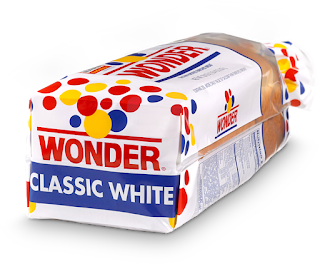In the early 1900s, Americans were worried about disease related to the cleanliness of their local bakeries, so many opted for factory-made bread, which they saw as clean and healthy. The fact that the bread was white seemed to help soothe anxieties especially when health columnists of the time were for this.
On May 21, 1921, the Taggart Baking Company of
Indianapolis produced a ‘Wonder’ for the consumers of that city. Wonder Bread
is impossibly soft and pillowy. That’s because of the process used to make it.
The flour is treated and softened, and other special chemicals prevent it from
drying out.
Taggart Vice President Elmer Cline
was watching the International Balloon Race at the Indianapolis Motor Speedway
when he remarked to a friend how in wonder of the balloons he was. The
proverbial light bulb went off. He christened the new product Wonder Bread and
incorporated the red, yellow, and blue balloons into its logo.To promote the newly launched Wonder Bread, Taggart Baking Company trucks delivered helium-filled balloons to children, who were asked to take a letter home to their mother. The letter, featuring a picture of the new loaf of Wonder Bread, invited the reader to try the new loaf of bread. The promotion caused Wonder Bread sales to increase above all other bread brands in the city.
Sliced bread was a marvel of technology when it was first rolled out. After purchasing Taggart in 1925, Continental Baking took Wonder Bread national, rolling out sliced bread in the 1930s. Wonder Bread was one of the first sliced breads on the market. Consumers were wary of pre-sliced bread because they thought that it might dry out, but their fears were unfounded. From 1943 to 1945, just about all commercially baked bread was sold unsliced due to a steel shortage during World War II.
Wonder Bread (and many other
mass-produced baked goods) are made with “enriched” flour. During processing,
when vital nutrients are stripped from wheat by bleaching and other methods,
just about all nutritional value is removed. During the 1940s, the government
set up a program that forced companies to return vitamins and minerals to
flour, thus “enriching” it and combating diseases like pellagra and beriberi in
the process. Today, Wonder Bread is still enjoyed by millions of Americans
across the nation where it’s packed in lunchboxes, served in restaurants, and
craved by those young and old.
“We're constantly being
bombarded by insulting and humiliating music, which people are making for you
the way they make those Wonder Bread products. Just as food can be bad for your
system, music can be bad for your spiritual and emotional feelings. It might
taste good or clever, but in the long run, it's not going to do anything for
you.” (Bob Dylan) [i]
[i] Sources used:
·
“5 Things You Didn’t Know
About Wonder Bread” by Dan Myers
·
“A History of Wonder” by
wonderbread.com
·
“Brand of the Day: The Good, the Bad and the Ugly of Wonder Bread” by Kristina
Monllos
·
“Weird Facts about Wonder Bread” by Joey Green




No comments:
Post a Comment